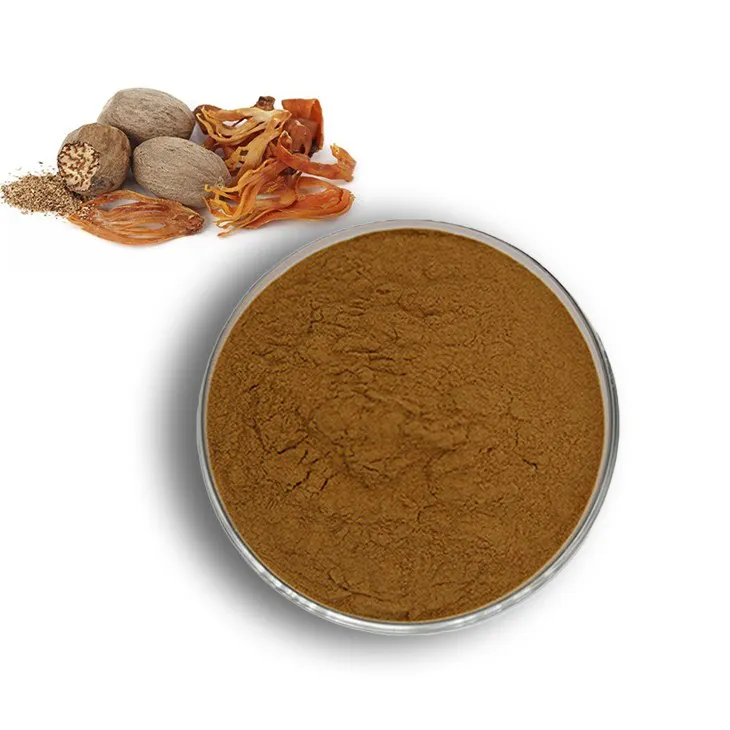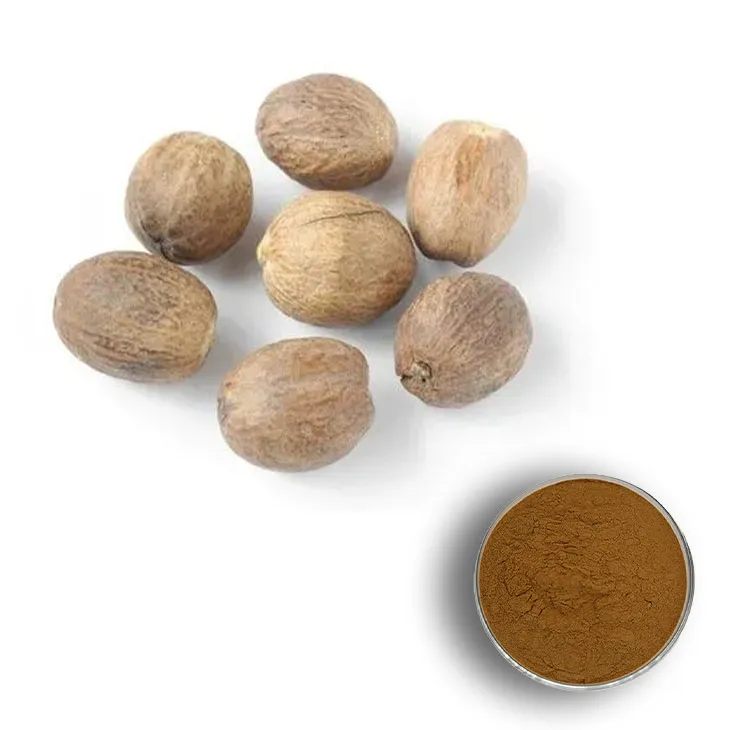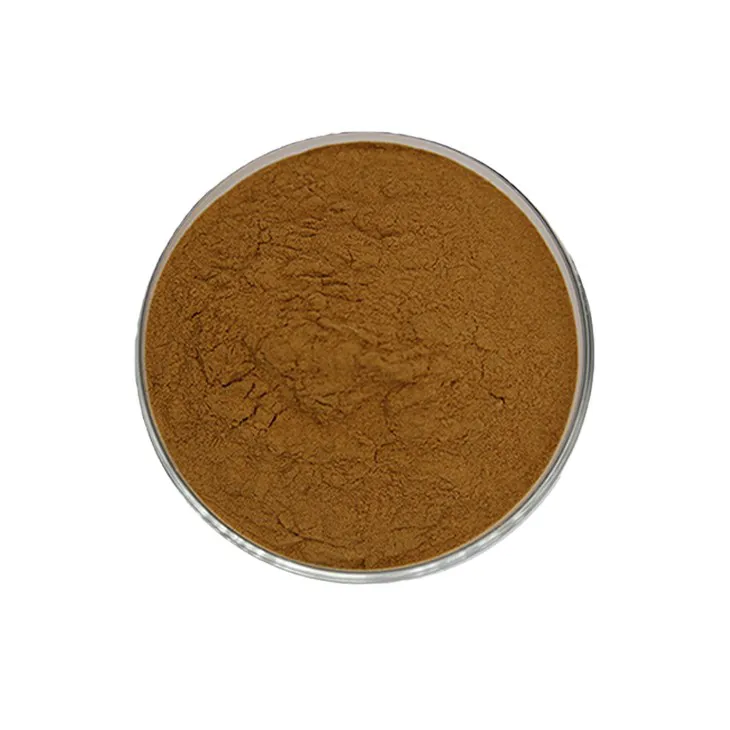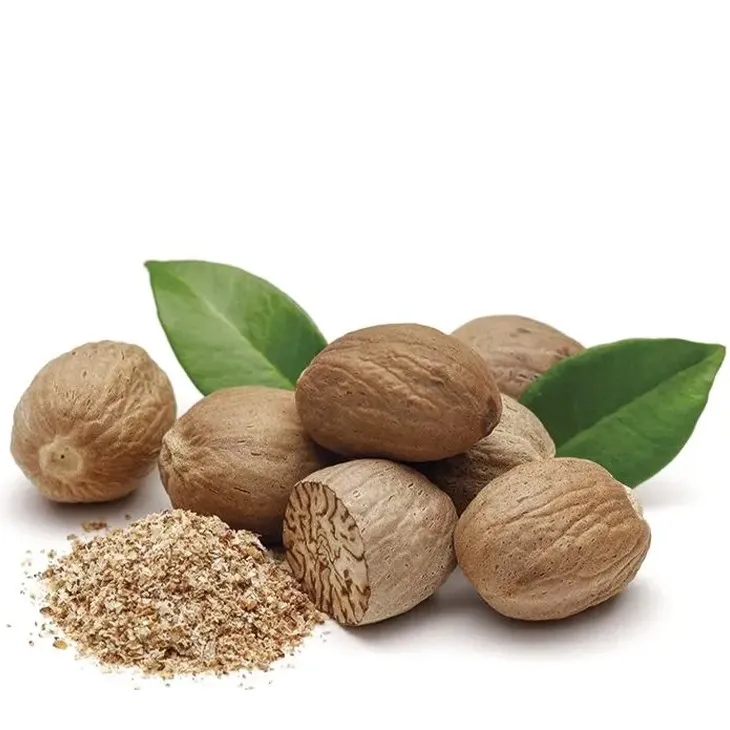- 0086-571-85302990
- sales@greenskybio.com
The process of extracting myristicin from nutmeg extract.
2024-11-28

1. Introduction
Nutmeg, a spice derived from the seed of the Myristica fragrans tree, has been used for centuries in various applications, especially in traditional medicine and cooking. The Nutmeg Extract contains a variety of compounds, among which lignans are of particular interest. Lignans are a class of polyphenolic compounds that have shown potential in numerous biological activities, such as antioxidant, anti - inflammatory, and antimicrobial properties. The extraction of nutmeg lignans from Nutmeg Extract is a crucial process that can unlock their potential for further applications in medicine, cosmetics, and food industries, as well as in high - tech bio - research.

2. Composition of Nutmeg Extract Relevant to Lignan Extraction
Nutmeg extract is a complex mixture of various chemical components. In addition to lignans, it contains essential oils, fixed oils, proteins, and other phenolic compounds. The main lignans present in nutmeg include myristicin, elemicin, and safrole, among others. These lignans are often bound to other molecules in the plant matrix, which makes their extraction a challenging task.
2.1 Essential Oils
The essential oils in nutmeg extract contribute to its characteristic aroma. These oils are mainly composed of terpenes and phenylpropanoids. While they are not lignans themselves, their presence can influence the extraction process of lignans. For example, they may interact with the solvents used for extraction, affecting the solubility and selectivity of lignan extraction.
2.2 Fixed Oils
Fixed oils are triglycerides present in nutmeg. They are non - volatile and can form a significant part of the nutmeg extract. Their high lipid content can interfere with the extraction of lignans, as they may form emulsions or compete for the extraction solvent. Therefore, it is necessary to consider the removal or separation of fixed oils during the lignan extraction process.
2.3 Other Phenolic Compounds
Besides lignans, nutmeg extract contains other phenolic compounds such as flavonoids and tannins. These compounds may have similar chemical properties to lignans, which can make the purification of lignans more difficult. However, they may also have synergistic effects with lignans in some biological activities, so their relationship needs to be carefully considered during extraction and subsequent applications.

3. Traditional Extraction Procedures
There are several traditional methods for extracting lignans from nutmeg extract.
-
3.1 Solvent Extraction
Solvent extraction is the most commonly used method for lignan extraction from nutmeg extract. This method involves the use of an appropriate solvent to dissolve the lignans from the nutmeg matrix. Commonly used solvents include ethanol, methanol, and ethyl acetate.
- In the case of ethanol extraction, the nutmeg extract is typically mixed with ethanol in a certain ratio, usually at room temperature or with gentle heating. The mixture is then stirred for a period of time, ranging from several hours to days, depending on the extraction efficiency required. After that, the solvent is separated from the solid residue, usually by filtration or centrifugation.
- Methanol extraction is similar to ethanol extraction. However, methanol is more polar than ethanol, which may result in a different selectivity in extracting lignans. It can dissolve some more polar lignan - related compounds more effectively, but it also has higher toxicity, which requires more careful handling.
- Ethyl acetate is a less polar solvent compared to ethanol and methanol. It is often used for the extraction of less polar lignans or for the purification step after the initial extraction with a more polar solvent. The extraction process with ethyl acetate usually involves shaking the nutmeg extract with the solvent in a separating funnel, allowing the two phases to separate, and then collecting the ethyl acetate phase containing the lignans.
-
3.2 Steam Distillation
Steam distillation is another traditional method for extracting certain components from nutmeg. Although it is not primarily used for lignan extraction, it can be used to remove some volatile components that may interfere with the subsequent lignan extraction. In steam distillation, steam is passed through the nutmeg extract, and the volatile components are carried away with the steam and condensed. However, this method is not very efficient for lignan extraction because lignans are generally not very volatile and may be degraded or lost during the high - temperature steam distillation process.

4. Role of Advanced Technologies in Enhancing Extraction Yield
With the development of modern technology, several advanced techniques have been applied to improve the extraction yield of nutmeg lignans.
-
4.1 Supercritical Fluid Extraction (SFE)
Supercritical fluid extraction has emerged as a promising method for lignan extraction. Carbon dioxide (CO₂) is the most commonly used supercritical fluid in this process. In the supercritical state, CO₂ has properties between those of a gas and a liquid, which gives it excellent solubility and diffusivity.
- The supercritical CO₂ can penetrate the nutmeg matrix more easily than traditional solvents, allowing for more efficient extraction of lignans. Moreover, it can be easily removed from the extract by simply reducing the pressure, leaving behind a pure lignan extract without any solvent residues.
- By adjusting the pressure and temperature conditions, the selectivity of lignan extraction can be controlled. For example, different lignans may be extracted preferentially at different pressure - temperature combinations, which is beneficial for the isolation and purification of specific lignans.
-
4.2 Microwave - Assisted Extraction (MAE)
Microwave - assisted extraction utilizes microwave energy to heat the extraction system. This method can significantly reduce the extraction time compared to traditional extraction methods.
- When the nutmeg extract is exposed to microwaves, the polar molecules in the system, such as water and some phenolic compounds, absorb the microwave energy and convert it into heat. This rapid heating creates a temperature gradient within the sample, which promotes the mass transfer of lignans from the matrix to the solvent.
- MAE also has the advantage of being more energy - efficient than traditional heating methods. It can be precisely controlled to avoid over - heating and degradation of lignans. However, the equipment for MAE is relatively more expensive, which may limit its widespread application in some small - scale extraction operations.
-
4.3 Ultrasound - Assisted Extraction (UAE)
Ultrasound - assisted extraction uses ultrasonic waves to disrupt the cell walls of the nutmeg matrix. This cavitation effect generated by ultrasound can enhance the extraction efficiency of lignans.
- When ultrasonic waves are applied to the nutmeg - solvent mixture, the formation and collapse of microbubbles in the liquid create intense local pressure and temperature changes. These changes can break down the cell walls of the nutmeg, releasing the lignans trapped inside.
- UAE is a relatively simple and cost - effective method. It can be combined with other extraction methods, such as solvent extraction, to further improve the extraction yield. However, the effectiveness of UAE may be affected by factors such as the frequency and intensity of the ultrasonic waves, which need to be optimized for different nutmeg samples.

5. Purification and Identification of Extracted Nutmeg Lignans
After the extraction of lignans from nutmeg extract, the next step is purification and identification.
-
5.1 Purification
- Column chromatography is a commonly used method for purifying nutmeg lignans. In this method, the crude extract is loaded onto a column filled with a stationary phase, such as silica gel or alumina. Different lignans will have different affinities for the stationary phase and the mobile phase (usually a solvent or a solvent mixture). By eluting the column with a suitable solvent system, the lignans can be separated and purified.
- High - performance liquid chromatography (HPLC) can also be used for purification, especially for the final purification of high - purity lignans. HPLC uses a high - pressure pump to force the sample through a column filled with a fine - particle stationary phase. The separation is highly efficient and can achieve very high - purity lignans.
-
5.2 Identification
- Spectroscopic methods are widely used for the identification of nutmeg lignans. For example, ultraviolet - visible (UV - Vis) spectroscopy can be used to detect the characteristic absorption peaks of lignans, which can provide initial information about their presence and concentration.
- Nuclear magnetic resonance (NMR) spectroscopy is a more powerful tool for the identification of lignans. It can provide detailed information about the molecular structure of lignans, such as the connectivity of atoms and the stereochemistry of the molecule. By comparing the NMR spectra of the extracted compounds with those of known lignans, the identity of the extracted lignans can be accurately determined.
- Mass spectrometry (MS) is also used in combination with other spectroscopic methods for the identification of lignans. MS can provide information about the molecular weight and fragmentation pattern of the compounds, which is useful for confirming their identity.
6. Implications of Nutmeg Lignan Extraction in Different Fields
The extraction of nutmeg lignans has far - reaching implications in various fields.
-
6.1 Traditional Medicine
In traditional medicine, nutmeg has been used for its various medicinal properties. Lignans, as important components of nutmeg, are believed to contribute to these medicinal effects. The extraction of lignans allows for a more targeted and controlled use of these compounds in traditional medicine formulations. For example, lignans may be used to develop new herbal remedies for digestive disorders, as they have been shown to have anti - inflammatory and antimicrobial properties that can help in treating gastrointestinal infections and reducing inflammation in the digestive tract.
-
6.2 Cosmetics
The antioxidant properties of nutmeg lignans make them attractive ingredients in cosmetics. They can be used to prevent skin aging by neutralizing free radicals that damage the skin cells. Lignans can also be incorporated into skin - care products such as creams and lotions to improve skin hydration and elasticity. Additionally, their anti - inflammatory properties may be beneficial for treating skin conditions such as acne and eczema.
-
6.3 Food Industries
In the food industry, nutmeg lignans can be used as natural preservatives due to their antimicrobial properties. They can extend the shelf - life of food products by inhibiting the growth of spoilage microorganisms. Moreover, lignans can also add a unique flavor to food products, as they are derived from nutmeg, which is a well - known spice. However, strict safety regulations need to be followed when using lignans in food, as some lignans may have potential toxicity at high doses.
-
6.4 High - Tech Bio - Research
Nutmeg lignans have attracted the attention of researchers in high - tech bio - research. Their unique chemical structures and biological activities make them potential candidates for drug discovery. For example, they may be used as lead compounds for the development of new drugs against cancer or neurodegenerative diseases. Additionally, the study of lignans can provide insights into plant - based natural products and their interactions with biological systems, which can contribute to the development of new bio - technologies.
7. Conclusion
The extraction of nutmeg lignans from nutmeg extract is a complex but highly rewarding process. Understanding the composition of nutmeg extract relevant to lignan extraction, using traditional and advanced extraction procedures, purifying and identifying the extracted lignans, and exploring their implications in different fields are all important aspects of this research. With the continuous development of technology and increasing interest in natural products, the extraction and application of nutmeg lignans are expected to have a bright future, bringing more benefits to various industries and research areas.
FAQ:
What are the main components in nutmeg extract relevant to lignan extraction?
Typically, nutmeg extract contains various compounds relevant to lignan extraction. These may include myristicin, elemicin, and safrole among others. These components are important as they are precursors or related substances in the lignan extraction process. They often have chemical properties that are exploited during extraction, such as solubility characteristics and reactivity.
What are the common extraction procedures for nutmeg lignans?
One common method is solvent extraction. This involves using solvents like ethanol or methanol to dissolve the lignans from the nutmeg extract. Another approach could be supercritical fluid extraction, which uses supercritical carbon dioxide. In solvent extraction, the nutmeg extract is soaked in the solvent for a period, and then the solvent is evaporated to obtain the lignans. Supercritical fluid extraction is often more efficient as it can be controlled more precisely and can often result in a purer product.
How do advanced technologies enhance the extraction yield of nutmeg lignans?
Advanced technologies such as microwave - assisted extraction can enhance the extraction yield. Microwaves can penetrate the nutmeg extract and cause rapid heating, which in turn increases the rate of diffusion of lignans into the solvent. Another technology is ultrasonic - assisted extraction. Ultrasonic waves create cavitation bubbles in the solvent, which helps in breaking down the cell walls of the nutmeg extract more effectively, thus releasing more lignans and increasing the yield.
What are the applications of nutmeg lignan extraction in traditional medicine?
In traditional medicine, nutmeg lignans have been used for various purposes. They may have anti - inflammatory properties, which can be used to treat conditions like arthritis. They also might have antimicrobial effects, which could be beneficial in treating infections. Additionally, they may play a role in digestive health, perhaps helping with issues such as indigestion or stomach cramps.
What are the implications of nutmeg lignan extraction in high - tech bio - research?
In high - tech bio - research, nutmeg lignans can be studied for their potential in drug development. Their unique chemical structures may serve as templates for the synthesis of new drugs. They can also be investigated for their antioxidant properties, which are relevant in the study of aging and age - related diseases. Moreover, they may have potential in cancer research, as some lignans have shown anti - cancer activities in preliminary studies.
Related literature
- Extraction and Characterization of Nutmeg Lignans for Medicinal Applications"
- "Advances in Nutmeg Lignan Extraction Technology and its Bioactivity"
- "The Role of Nutmeg Lignans in Traditional and Modern Therapeutics: An Overview of Extraction and Application"
- ▶ Hesperidin
- ▶ citrus bioflavonoids
- ▶ plant extract
- ▶ lycopene
- ▶ Diosmin
- ▶ Grape seed extract
- ▶ Sea buckthorn Juice Powder
- ▶ Beetroot powder
- ▶ Hops Extract
- ▶ Artichoke Extract
- ▶ Reishi mushroom extract
- ▶ Astaxanthin
- ▶ Green Tea Extract
- ▶ Curcumin Extract
- ▶ Horse Chestnut Extract
- ▶ Other Problems
- ▶ Boswellia Serrata Extract
- ▶ Resveratrol Extract
- ▶ Marigold Extract
- ▶ Grape Leaf Extract
- ▶ blog3
- ▶ blog4
-
The best alfalfa powder on the market.
2024-11-28
-
Super Essence of Natural Lemon Extract.
2024-11-28
-
Organic Hawthorn Powder Suppliers.
2024-11-28
-
Organic cocoa extract of trace components.
2024-11-28
-
The best - quality vitamin K2.
2024-11-28
-
Propolis Extract Powder
2024-11-28
-
Acai Berry Extract
2024-11-28
-
Plantain extract
2024-11-28
-
Polygonum multiflorum extract
2024-11-28
-
Sea buckthorn Juice Powder
2024-11-28
-
Curcumin Extract
2024-11-28
-
Agaricus Blazei Extract
2024-11-28
-
Sea buckthorn oil
2024-11-28
-
Motherwort Extract
2024-11-28
-
Pueraria Lobata Extract
2024-11-28





















